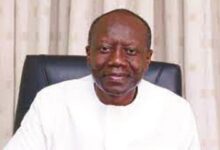The Monetary Policy Committee (MPC) of the Bank of Ghana (BoG) for the second time this year maintained the policy rate at 16 per cent, citing positive economic growth and inflation outlook and external sector development.
The Governor of BoG, Dr Ernest Addison, who announced the new policy rate a news conference in Accra yesterday after the 88th regular meeting of the MPC, said “core inflation remained subdued and inflation expectations fairly anchored”.
He said economic growth remained relatively strong and was projected to gain some additional momentum over the horizon, supported by crude oil production.
“Early indications already show that economic activity in the first quarter is picking up pace as evidenced by the bank’s Composite Index of Economic Activity (CIEA). Other factors such as improving business sentiments and credit growth are supportive of the growth in the outlook,” the Governor who is also the Chairman of the MPC, said.
He observed that the CIEA showed evidence of increased economic activity with a yearly growth of 4.0 per cent in March, up from 2.9 per cent a year earlier; stressing this “robust pace of economic activity is supported by improved sentiments from businesses following the Ghana’s Cedi’s recovery from the recent sharp depreciation and favourable growth prospects”.
Dr Addison said the strong external sector developments in the first quarter, emanating from a strong trade surplus outturn and improved inflows into the capital and financial account.
“In the outlook, the trade balance is expected to record surpluses, bolstered by the oil sector and a pickup in private transfers to support an improving current account balance,” he said.
Dr Addison said the current account balance for the first quarter of 2019 registered a surplus of $294.5 million, equivalent to 0.4 per cent of Gross Domestic Product (GDP), on the back of an improved trade surplus of $794.4 million (1.2 per cent of GDP) and a net outflow of $500 million in the services and income account.
He added that the positive outturn in the current account balance, coupled with the significant inflows into the capital and financial account balance, driven mainly by the March 2019 Eurobond issue resulted in a balance of payment surplus of $3.0 billion (4.4 per cent of GDP) for the first quarter of 2019.
“These developments improved Ghana’s Gross International Reserves (GIR) to $9.9 billion (equivalent to 5.1 months of import cover) at the end of March 2019 from $7.0 billion (equivalent to 3.6 months of import cover) at the end of December 2018,” Dr Addison said.
He said the GIR as at the end of April this year stood at $9.3 billion (4.7 months of import cover), and was largely on account of energy-related debt payments and higher obligations associated with externally held domestic debt payments.
By Kingsley Asare





